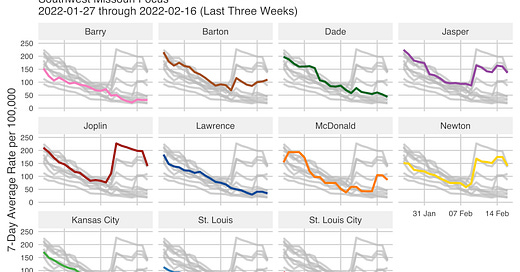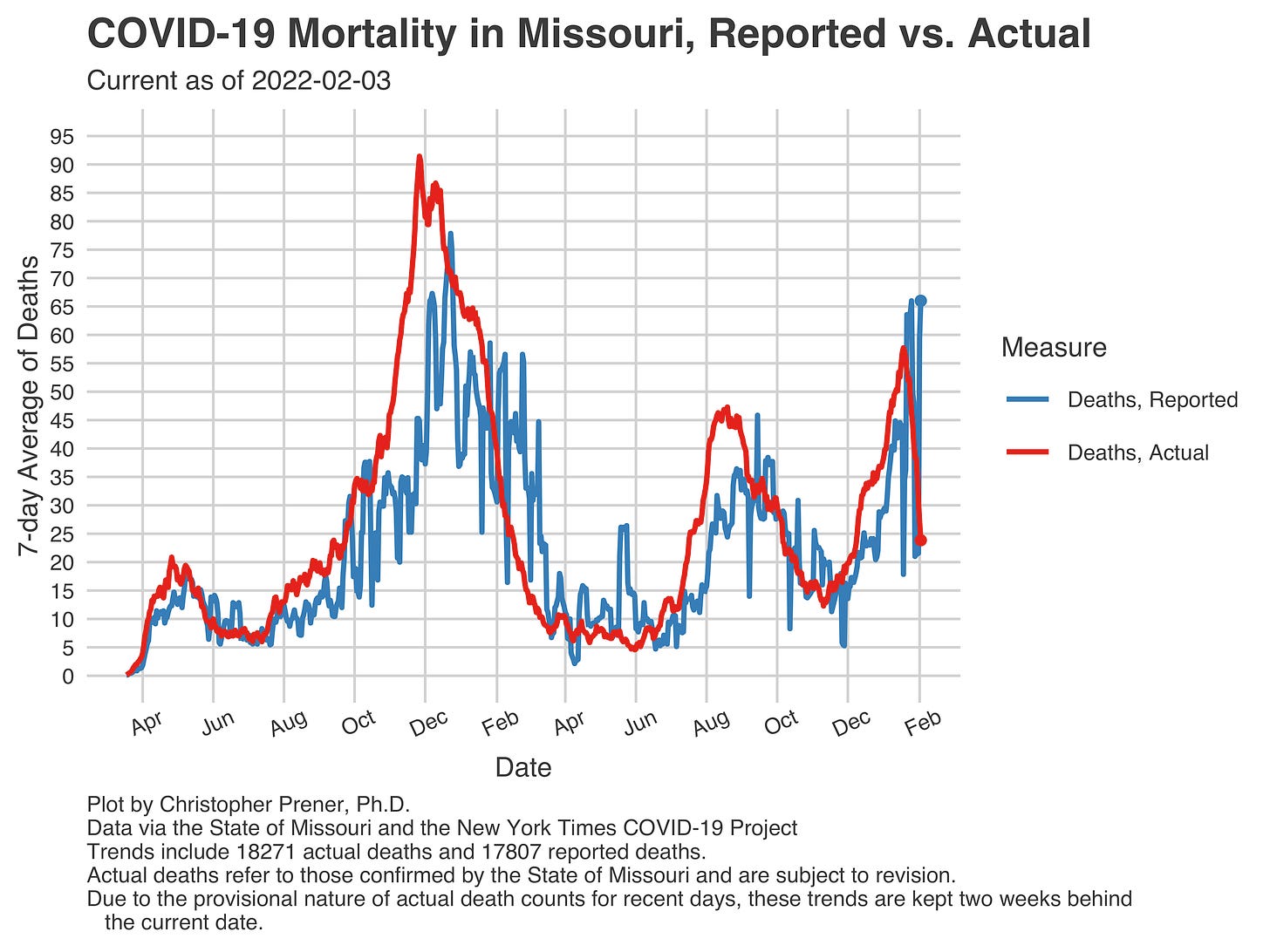The improvements in COVID-19 cases continued across Missouri this week, and we have positive trajectories on hospitalizations as well. Despite that, we need to proceed cautiously in communities that continue to have masking requirements in schools or public places. When transmission remains high, removing protections too quickly may seed another spike or mean that our reductions slow considerably. For some context, only one county - Worth - out of 115 in Missouri has a CDC risk rating below high. Our test positivity rate statewide is still above 10%. Pairing the removal of masking and other measures to reduced CDC risk ratings and test positivity is one way to develop a principled way to deescalate (and re-introduce) non-pharmaceutical interventions. - Chris
COVID-19 by the Numbers
Total cases in MO: 1,401,054 (+18,280 from last Thursday)
7-day average of new cases per day in MO: 2,611.43 (-618.29 from last Thursday)
Counties with the highest per capita rates (per 100,000) of new cases per day this past week:
Atchison (143.67 per 100,000), Newton (140.96), Joplin (139.8), Jasper (135.95), Barton (109.7), Clay (107.19), Montgomery (103.94), Platte (94.31), McDonald (86.36), and New Madrid (85.02)
Total deaths in MO: 18,549 (+358 from last Thursday)
7-day average of new deaths per day in MO: 51.14 (-3.71 from last Thursday)
Percent of all Missourians initiating vaccination: at least 58% (no change from last week)
Percent of all Missourians completing vaccination: at least 52% (no change from last week)
Case and mortality numbers are current as of Wednesday, February 16th. Vaccination numbers are current as of Thursday, February 17th. Additional statistics, maps, and plots are available on my COVID-19 tracking site.
Trends in the Past Week
I want to lead with a caveat about data quality right now in Missouri. Many counties in Missouri had a noticeable uptick in reported cases last Thursday, followed by three days (Friday-Sunday) of zero cases reported. Nowhere was this more pronounced than in the Joplin area - you can see the trends jump suddenly in Jasper, Newton, and McDonald counties as well as in Joplin itself.
Other counties did not seem to have an odd number of cases last Thursday but still had nothing reported for three days over last weekend.
There are two possibilities here I am considering. First, the significant snow last week may have meant delays in processing tests and/or updates to the State’s dashboard. Perhaps this explains a dump of cases on Thursday, though it would not explain the absence of cases reported over the weekend.
The other possibility is that DHSS is dialing back their reporting again. Last fall, we saw the pattern where counties did not report new cases on Saturdays and Sundays. I am especially curious to see whether this pattern repeats this weekend.
Despite the increased volatility in our seven-day averages, the overall trajectory remains downward. As I have mentioned before, however, downward is relative. Cases are far below their peak in early January, but the same pattern is occurring in both Kansas City and “Outstate” Missouri. In both places, the current rate is near the peaks of their Delta wave. In Kansas City, rates are similar to their prior all-time high in November 2020.
Meanwhile, St. Louis has some of the best news. Regionally, rates have plummeted below any of the three waves we have better data for (November 2020, Delta, and Omicron). Indeed, rates are now at a point that is roughly comparable to our spring and fall 2021 numbers between our limited Delta surge.
Things are the best in St. Louis City, whose rates are now below twenty new cases per 100,000 people per day on average over the past week. That’s about sixty cases per day. We have been as low as six or eight new cases per 100,000 last spring. That said, this is an outstanding milestone for us. Only Worth County in Northern MO is lower. Regionally, Warren County is below twenty new cases per 100,000 people per day metric, and St. Louis County is just over that line. St. Charles County is a bit higher but ranks comparatively low relative to other counties in Missouri.
Hospitalizations also continue to improve in Missouri. Earlier this month (the most recent data), every metro showed signs of either peaking (Cape Girardeau, Joplin, and Springfield) or steady declines in the number of COVID patients hospitalized in each region.
Here in St. Loui,s you can see the decline developing clearly. We are below 500 patients on our one-day value and nearly below 500 on our seven-day average. I am hopeful the rate of decline remains aggressive, and we can see hospitalization numbers soon that are comparable to what we saw last spring.
Pediatric hospitalizations are also declining again as well after plateauing. We are getting back to our pre-Omicron but post-Thanksgiving numbers of hospitalizations, which almost certainly reflected Delta variant infections.
Unfortunately, what we are likely not done with are significant deaths. Part of the decline in hospitalizations is due to patients dying each day. Those numbers have dropped by nearly half from their Omicron peak but remain above the daily average mortality between February 2021 and the very beginning of January 2022. That period includes a significant jump in deaths during the Delta wave in St. Louis’s hospitals.
Where we ultimately land in Missouri with mortality is still an open question. It takes three or four weeks to see deaths reflected in our trends, given the pace at which DHSS reports death certificate information. There was an average of just below sixty deaths per day statewide by late December. This average is almost certainly still an undercount, and you can all but ignore the sharp decline afterward. Revisions over the next month will almost certainly show that deaths peaked at a higher rate than what appears on the plot right now and declined more slowly over February. Nevertheless, we can already say that December and January were one of the deadliest periods of the pandemic in terms of the total count of deaths. Omicron may be milder on average, but it has nevertheless taken the lives of many of our neighbors.











